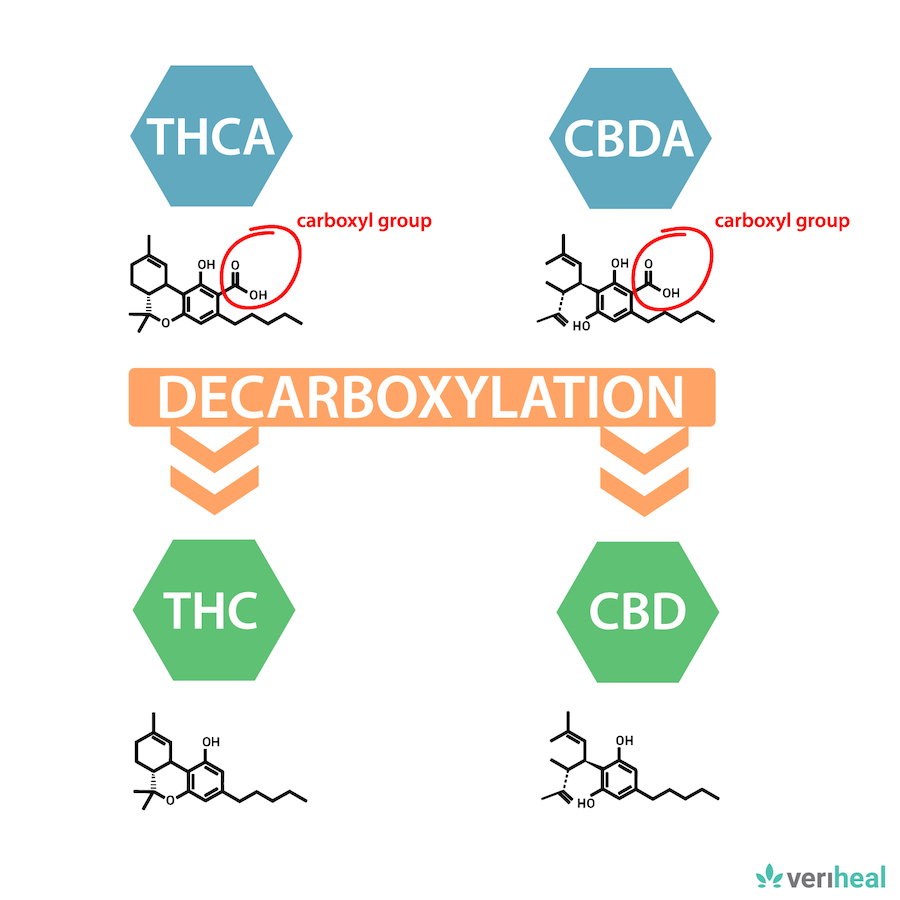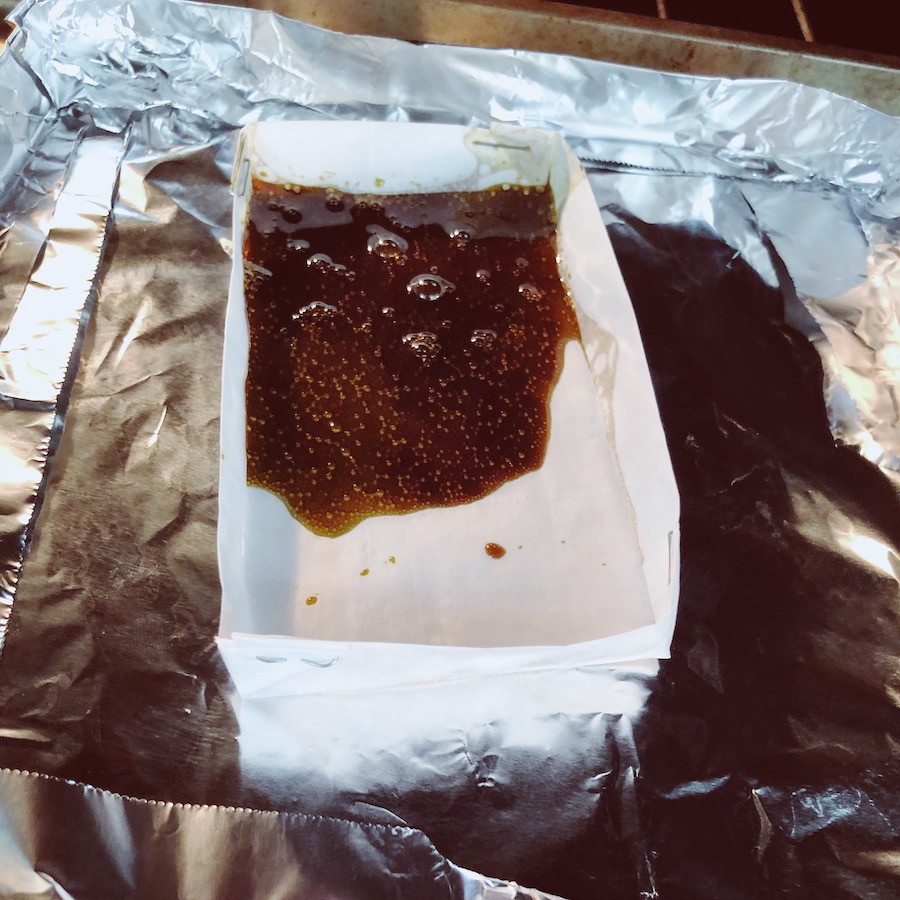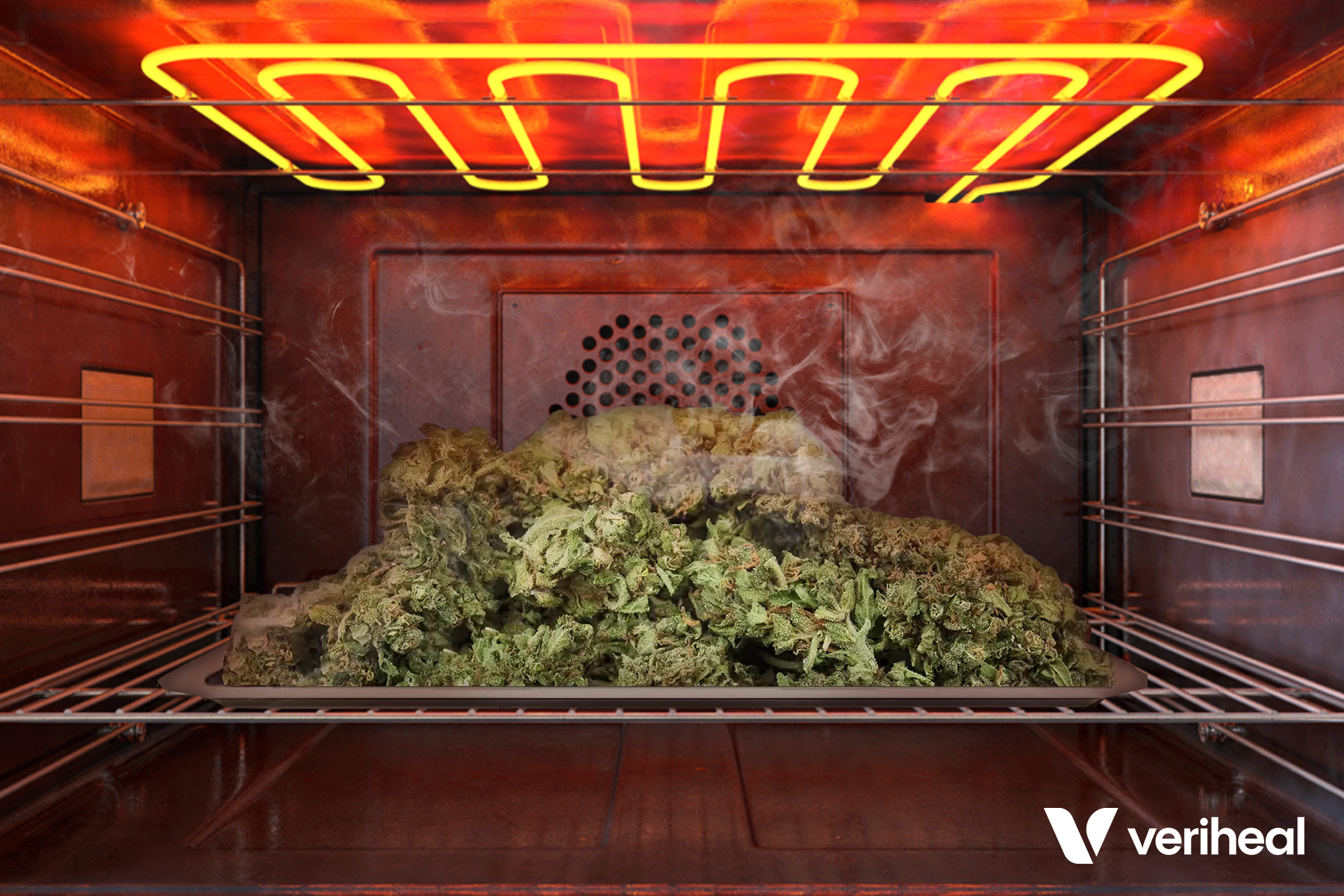If you’ve ever eaten raw cannabis flower hoping to get high, you were probably disappointed. That’s because you need to decarb your cannabis first.
THC (the chemical compound responsible for the “high” and psychoactive effects) doesn’t exist in significant amounts in raw cannabis. Neither does CBD, a cannabinoid known for its beneficial anti-inflammatory effects and for relieving anxiety. The cannabinoids THC and CBD actually start out as the cannabinoids THCA and CBDA, which both have an additional carboxyl group in their molecular makeup.
- The Science Behind Cannabis Decarboxylation
- Decarbing Cannabis at Lower Temperatures
- Different Methods to Decarboxylate Cannabis
- What Happens if You Forget to Decarboxylate Cannabis?
- Decarboxylating Weed for Butter
- Decarboxylation Temperature for CBD
- Storing Decarbed Cannabis
- Final Takeaway
The Science Behind Cannabis Decarboxylation
In scientific terms, decarboxylation is a chemical reaction that removes a carboxyl group from a molecule. A carboxyl group in molecular form is identified as COOH, or a carbon atom that is double-bonded to an oxygen and an -OH group. (See the graphic below for a simple illustration of the carboxyl groups in THCA and CBDA.) Decarboxylation occurs naturally at a very slow rate, but it can be expedited when a certain level of heat is applied for an amount of time that allows for the molecules to break down and be released as carbon dioxide (CO2).
 With their carboxyl groups still attached, THCA and CBDA cannot effectively bind to our cannabinoid receptors. This would explain why you won’t experience any euphoric effects if you ingest it in raw form. In order to be bioavailable to our endocannabinoid system, these cannabinoid molecules must undergo decarboxylation. That is why it is so important to decarb your cannabis before making edibles and why heat needs to be applied for it to be medically effective.
With their carboxyl groups still attached, THCA and CBDA cannot effectively bind to our cannabinoid receptors. This would explain why you won’t experience any euphoric effects if you ingest it in raw form. In order to be bioavailable to our endocannabinoid system, these cannabinoid molecules must undergo decarboxylation. That is why it is so important to decarb your cannabis before making edibles and why heat needs to be applied for it to be medically effective.
Decarbing Cannabis at Lower Temperatures
Decarbing cannabis should usually be done at high temperatures. In fact, when you take a lighter to cannabis buds in a pipe, joint, or bong—or when you turn on a vape pen—you are decarbing it by applying heat! When it comes to edibles, topicals, and other cannabis products though, cannabis should be decarbed at lower temperatures for longer periods of time.
It’s easy to burn off cannabinoids if you use the wrong temperatures or when decarbing for too long. When decarbing for edibles, using lower heat for a longer period of time allows one to preserve the cannabinoids (especially THC, the psychoactive compound) as well as the terpenes (the aromatic compounds found in plants that have their own set of benefits and give cannabis its flavor).
Additionally, decarboxylation at lower temperatures allows the THCA to be converted to THC, as opposed to CBN, the sleepy cannabinoid. Low and slow is key. Let’s go over how to decarb in more detail, so you can enjoy cannabis in its many forms at the potencies necessary for your medical needs.
Does Heating Up Weed Make It Stronger?
When you consider the fact that decarboxylated weed contains activated compounds that are psychoactive, heating up cannabis does make it stronger. Heating up weed is essential for converting THCA and CBDA into THC and CBD.
Should You Use a Grinder Before Decarbing?
There is a debate within the cannabis community about whether flower should be broken up with a grinder or by hand during the decarbing process. Many seasoned cannabis consumers swear that using your hands disturbs fewer trichomes, the microscopic hairs on buds that store cannabinoids and terpenes. Plus, feeling the cannabis with your hands is an important part of the ritual and experience for some.
Others argue that using a grinder prevents sticky fingers. If you’ve ever broken up cannabis with your hands, you’ve probably noticed the sticky residue left behind. The trichomes tend to stick to your skin, thus causing your flower to lose some of its potency. Supporters of the grinder method also argue that using a three-chambered grinder allows you to collect kief. Collecting kief means you can still use it, whereas trichomes stuck to your hands end up wasted. Additionally, kief can be decarbed and used in cannabis edibles, tinctures, cannabutter, etc. Grinders can be purchased at affordable prices, but the choice of whether or not to use one is yours.
Different Methods to Decarboxylate Cannabis
Combustion, or smoking, is the quickest and most convenient way to decarb cannabis. This can be done through a variety of different approaches like taking a flame to a pipe, joint, or handmade device. If smoking isn’t a preference, vaporization of cannabis—with options like portable vaping devices—would be the next most effective method for decarbing.
Do be aware that decarboxylated cannabis can be a very aromatic endeavor that will produce a strong smell in your home. However, this is also dependent on the size of your house and the extent of the ventilation. The smell will most likely dissipate within 30 minutes to an hour after you have finished decarboxylating. Some decarboxylators on the market claim that they produce no smell.

Oven (Decarb Cannabis Concentrates)
Using the oven to decarb isn’t just for flower; you can also decarb concentrates in the oven.
Steps:
- Preheat the oven to 200°F.
- Line a baking sheet with parchment paper and place the concentrate on it.
- Place the baking tray in the oven for 20 minutes.
- Once the concentrate is thoroughly heated, it will start to bubble. Turn the oven off and allow the concentrate to cool off inside the oven.
- After cooling down, the concentrate will be very sappy and sticky.
- Put the concentrate in the freezer for about 10 minutes, so it can easily be removed from the parchment and used to make homemade edibles and cannabis-infused oils.
Mason Jar
Using a mason jar to decarb is a good option if you want to cut down on the smell of weed in your kitchen. Any compounds that evaporate during the heating process will remain in the jar, so using the jar as the container for your infusions will conserve them in the final product.
Steps:
- Set the oven temperature to 220°F.
- Grind up your cannabis flower or break it up with your hands.
- Place the flower in a mason jar with the lid lightly screwed on.
- Slightly moisten a kitchen towel and place it on a baking sheet. Then, place the mason jar on the towel, laying down.
- Put the baking sheet on the middle rack of the oven for an hour.
- Every 15 minutes, take out the mason jar and shake it. Remember to use oven mitts as the jar will be very hot, and make sure the cannabis is spread evenly before returning the jar to the oven.
- After an hour, take the jar out of the oven and let it cool for 30 minutes before using or storing it.
Sous Vide
With a sous vide immersion circulator or a precision cooker, you can use a sous vide bag to decarb your cannabis. With this option, there’s very little smell, the plant compounds and flavor are preserved, and the temperature is precisely monitored the entire time.
Steps:
- It’s important to grind your flower for this method before placing it in a sous vide bag.
- Vacuum seal the sous vide bag.
- If you have a sous vide immersion circulator: Fill a pot with water. Place the immersion circulator in the pot and set it to 203°F. Place the sealed bag containing the cannabis into the water for 90 minutes. Alternatively, you can accomplish this with a sous vide precision cooker.
- If you don’t have a sous vide precision cooker: Fill a saucepan with water and bring it to a boil over high heat. Once boiling, reduce the heat and use a thermometer to monitor and keep the temperature between 203-212°F. When the temperature is right, place the bag into the water for 90 minutes.
- Take the bag out of the water. Use caution as the bag and the water will be very hot. Let the bag cool and dry for at least 20 minutes. Take out the flower and use it or store it.
Decarboxylator
Decarboxylators are devices designed to make decarbing easier. They automatically control the temperature and time cycles during the decarboxylation process, so you don’t have to monitor it closely like you would when using the stovetop or the oven. While decarboxylators can be expensive, they are convenient and easy-to-use; some models only require you to place the cannabis inside and press a button. Review the instructions that came with your specific decarboxylator as the steps may differ depending on the device and brand.
Steps:
- Plugin the device.
- Place the cannabis flower directly into the device. Some units require you to take out a container, place the flower inside, and put it back into the device.
- Press the button and wait for the device to stop.
Recommended decarboxylator brands include the Levo II, Ardent FX, Ardent Nova, Magicalbutter DecarBox, and MB2e MagicalButter Machine. With some models, infusions can be made directly inside of the unit, like infused butter, oils, and tinctures.
Natural Decarboxylation
Over time, cannabis will decarb naturally, and the THCA will convert to THC. You may have noticed that older weed starts to turn brown, a sign of the process. However, this takes a very, very long time. It’s still recommended that you decarb your flower using a different method if you plan on using it to make edibles to get the most out of your stash.
After you finish decarbing, your cannabis is then activated and ready to use at your disposal! There are many cannabis recipes out there and most require that you first decarb your cannabis. Always take care not to burn your cannabis; burning will compromise the THC and CBD availability and effectively ruin it.
What Happens if You Forget to Decarboxylate Cannabis?
The worst that can happen if you forget to decarb your weed is that your infusions will have no psychoactive effects. If you forgot to decarb the cannabis before cooking with it, the heat applied while cooking may still bring out some effects. Whereas consuming it without having exposed it to any form of heat will result in no effects as the THCA and CBDA will not have had the chance to convert into the active compounds THC and CBD. None of us like wasting plant medicine though, so always be sure to decarb appropriately.
Do You Have to Decarboxylate Weed for Butter?
For the best results, it is recommended that you decarboxylate weed for butter. If you do not decarboxylate weed for infusing butter, you will mostly end up with a weaker or inactive product, as described in the above section. Some decarboxylators allow you to infuse butter directly in the device. The same is true with infused coconut oil.
At What Temperature Does CBD Decarboxylate?
If you are using the correct temperatures within the allocated time frames, CBD will not be destroyed. The general consensus is that CBD should not be decarbed at temperatures higher than 230°F to avoid any loss of the compound.
Storing Decarbed Cannabis
In order to maintain the freshness and extend the shelf life of your decarbed weed, it is important that you properly store it. Select an airtight container like a mason jar and store it in a cool, dry, and dark place. If stored correctly, it is recommended that you use it within 3 months to avoid any degradation of the cannabinoids and other compounds. Some patients prefer to decarb large batches at once, so there is plenty on hand for medicating.
Final Takeaway
Decarboxylating cannabis can sound intimidating, but it’s merely the process of applying the proper heat to raw cannabis flower to activate the cannabinoids. Without activation, you won’t get to enjoy the specific benefits and effects you’re seeking. Once you become comfortable with any form of cannabis decarboxylation, you’ll be able to enjoy all that cannabis has to offer!
This guide is a compilation of articles written by Lauren Dragoo and Chane Leigh. This article was originally published in August, 2021 and updated in June, 2023.
FAQs
-
Why do you need to decarb cannabis?
Decarboxylation is necessary to activate the cannabinoids THC and CBD in cannabis, making them bioavailable and capable of producing their desired effects.
-
What happens if you don’t decarb cannabis?
If cannabis is not decarboxylated, the THCA and CBDA present in raw cannabis will not convert into psychoactive THC and CBD, resulting in little to no psychoactive effects when consumed.
-
What are the best methods to decarb cannabis?
Popular methods for decarbing cannabis include using an oven, a sous vide immersion circulator, or a dedicated decarboxylator. Each method has its advantages, but the key is to apply the right amount of heat for the right duration to activate the cannabinoids without degrading them.


